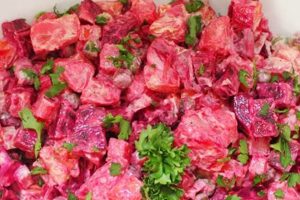A dish featuring boiled, sliced potatoes with thin, edible red skins, often combined with mayonnaise, mustard, celery, onions, and hard-boiled eggs. Variations can include different herbs, spices, and other vegetables. This type of potato salad is known for its creamy texture and the slightly waxy, firm consistency of the potatoes, which hold their shape well after cooking.
This specific combination of ingredients offers both nutritional value and culinary appeal. Red potatoes are a good source of potassium and fiber, while eggs provide protein and essential vitamins. The flavorful blend of ingredients creates a versatile side dish suitable for picnics, barbecues, and holiday gatherings. Historically, potato salad emerged as a popular dish in Europe and later gained prominence in the United States, evolving into numerous regional variations. The use of red potatoes specifically contributes a visually appealing color and distinct textural element.
Further exploration of this culinary topic will cover variations in ingredients, preparation methods, and suitable pairings, offering a deeper understanding of its creation and enjoyment.
Tips for Preparing a Superior Potato Salad
Achieving a desirable outcome requires attention to detail in ingredient selection and preparation techniques. The following tips offer guidance for creating a flavorful and visually appealing dish.
Tip 1: Selecting Potatoes: Choose firm, unblemished red potatoes of uniform size for even cooking. Avoid potatoes with sprouts or green spots.
Tip 2: Cooking Potatoes: Boil potatoes until tender but not mushy. Overcooked potatoes will result in a less desirable texture. Slightly undercooking ensures the potatoes maintain their shape when mixed with other ingredients.
Tip 3: Cooling Potatoes: Drain the cooked potatoes immediately and spread them out to cool quickly. This prevents further cooking and helps them maintain their firmness.
Tip 4: Egg Preparation: Cook eggs to a firm yolk stage for easier slicing and chopping. Immediately cool the eggs in ice water to prevent a greenish ring from forming around the yolk.
Tip 5: Dressing Consistency: The mayonnaise-based dressing should be creamy and well-combined. Adjust the consistency by adding small amounts of milk or sour cream if needed.
Tip 6: Ingredient Incorporation: Gently fold the dressing and other ingredients into the cooled potatoes to avoid breaking them. Overmixing can result in a mushy salad.
Tip 7: Chilling and Serving: Chill the salad for at least an hour before serving to allow the flavors to meld. Garnish with fresh herbs or paprika for added visual appeal.
Following these guidelines will result in a potato salad with a pleasing texture and a balanced flavor profile, enhancing the overall dining experience.
By implementing these techniques, one can confidently create a potato salad that is both visually appealing and delicious, suitable for any occasion.
1. Red Potatoes
Red potatoes are fundamental to this specific potato salad variation, contributing distinct characteristics that differentiate it from other potato salads. Their properties directly influence the dish’s texture, flavor, and visual appeal. Understanding these attributes provides a foundation for appreciating their role in the recipe.
- Texture and Density:
Red potatoes possess a firm, waxy texture that holds its shape well during boiling and mixing. This characteristic prevents the potatoes from becoming mushy, ensuring a pleasant texture in the final salad. Their density also allows them to absorb flavors from the dressing and other ingredients without becoming overly saturated.
- Thin Skin and Flavor:
The thin, edible skin of red potatoes adds a subtle earthy flavor and vibrant color to the salad. Leaving the skin on not only contributes visual appeal but also retains nutrients and simplifies preparation. The skin’s delicate nature prevents it from becoming tough or unpleasant during cooking.
- Visual Appeal:
The bright red hue of the potato skins contributes significantly to the salad’s visual appeal. This vibrant color contrasts nicely with the other ingredients, creating an attractive presentation. The consistent color throughout the potato flesh also enhances the overall aesthetic.
- Nutritional Value:
Red potatoes offer nutritional benefits, including potassium, vitamin C, and dietary fiber. Their inclusion in the salad contributes to a more wholesome and nutritious dish. Retaining the skin maximizes the fiber content.
The combination of these characteristics makes red potatoes an ideal choice for this particular potato salad. Their firm texture, thin skin, visual appeal, and nutritional value contribute significantly to the overall quality and enjoyment of the dish. Choosing the right potato variety is paramount to achieving the desired outcome, highlighting the integral role of red potatoes in a successful red skin potato salad.
2. Hard-boiled Eggs
Hard-boiled eggs constitute a crucial element within red skin potato salad, contributing significantly to its nutritional value, textural complexity, and overall flavor profile. Their presence offers a protein-rich counterpoint to the starchy potatoes and creamy dressing. The distinct texture of the egg white and yolk adds another dimension to the salad’s mouthfeel, contrasting with the softer potatoes and the smooth dressing. Furthermore, the subtle, slightly sulfurous taste of hard-boiled eggs enhances the overall savory character of the dish. For instance, a classic red skin potato salad often incorporates the yolks into the dressing itself, adding richness and a creamy yellow hue. This incorporation not only contributes to the dressing’s flavor but also its texture and visual appeal. The whites, typically chopped, are then folded into the salad, providing bursts of firm texture throughout each bite.
The inclusion of hard-boiled eggs also offers practical advantages. Their readily available nature and ease of preparation make them a convenient addition. Additionally, their nutritional density, including protein, vitamins, and minerals, elevates the nutritional profile of the salad beyond that of a simple starch and vegetable side dish. Variations exist in how eggs are incorporated, from fully integrating the yolks into the dressing to slicing or coarsely chopping both whites and yolks for a more pronounced textural contrast. The method chosen influences both the presentation and the eating experience. For example, a deviled egg potato salad, a popular variation, mashes the yolks with spices and mayonnaise before incorporating them back into the salad, thereby intensifying the egg flavor and creating a richer, more complex flavor profile.
In summary, the integration of hard-boiled eggs into red skin potato salad provides essential nutritional value, adds textural complexity, and contributes to a well-rounded flavor profile. The versatility in preparation methods allows for customization to individual preferences, further demonstrating the importance of hard-boiled eggs as a core ingredient in this classic dish. Understanding the multifaceted contribution of eggs enables a more informed approach to recipe development and appreciation of this culinary staple.
3. Mayonnaise-based dressing
Mayonnaise-based dressing forms the foundational element that binds the components of red skin potato salad with egg into a cohesive and flavorful whole. Its creamy texture coats the potatoes and other ingredients, creating a smooth mouthfeel and distributing flavor evenly throughout the salad. The emulsification inherent in mayonnaise allows it to act as a bridge, connecting disparate elements such as the starchy potatoes, the rich eggs, and the often acidic or pungent additions like mustard or vinegar. Without this binding agent, the individual components would remain separate, lacking the characteristic creamy texture and unified flavor profile of a true potato salad. Classic recipes frequently incorporate the yolks of the hard-boiled eggs directly into the mayonnaise, enriching its flavor and color while simultaneously adding a subtle tang. This technique exemplifies the symbiotic relationship between the dressing and the egg component of the salad.
Variations in the mayonnaise base offer opportunities for customization and flavor complexity. Substituting a portion of the mayonnaise with sour cream or plain yogurt can lighten the texture and introduce a subtle tang. The incorporation of herbs, spices, and other flavoring agents like Dijon mustard, horseradish, or smoked paprika can further personalize the dressing and tailor it to specific taste preferences. For instance, a Southwestern-inspired potato salad might utilize chipotle mayonnaise and chopped cilantro, while a classic picnic version may favor a simple blend of mayonnaise, yellow mustard, and celery seed. These examples demonstrate the versatility of the mayonnaise base and its ability to adapt to a wide range of flavor profiles. Furthermore, the consistency of the dressing plays a critical role in the overall success of the salad. Too thick a dressing can overwhelm the other ingredients, while too thin a dressing fails to adequately coat and bind them together. Achieving the right balance is essential for a harmonious final product.
In conclusion, mayonnaise-based dressing is more than just a condiment in red skin potato salad with egg; it is the unifying force that brings all the elements together. Its creamy texture, ability to bind diverse ingredients, and adaptability to various flavor profiles make it an indispensable component. Understanding the function and potential of the mayonnaise base allows for informed decision-making during recipe development, leading to a potato salad that achieves a harmonious balance of flavors, textures, and visual appeal. The careful consideration of this key element ensures a successful and satisfying culinary outcome.
4. Complementary Ingredients
Complementary ingredients in red skin potato salad with egg elevate the dish beyond a simple combination of potatoes and mayonnaise, adding depth, complexity, and textural contrast. These additions contribute not only to the flavor profile but also to the visual appeal and overall enjoyment of the salad. Careful selection and balancing of these components are essential for a well-rounded and satisfying culinary experience.
- Aromatics:
Aromatics such as onions and celery provide a pungent counterpoint to the creamy richness of the mayonnaise and the earthy notes of the potatoes. The sharp bite of raw onion, whether red, white, or yellow, adds a crisp texture and a distinct flavor. Celery contributes a subtle vegetal sweetness and a satisfying crunch. The choice and quantity of aromatics significantly influence the final flavor profile. For example, a finely diced red onion offers a milder flavor and vibrant color, while a coarsely chopped white onion delivers a more assertive presence.
- Acidic Components:
Ingredients like vinegar or mustard introduce acidity, balancing the richness of the mayonnaise and brightening the overall flavor profile. A splash of apple cider vinegar provides a subtle sweetness, while white vinegar delivers a sharper tang. Mustard, whether yellow, Dijon, or whole grain, adds complexity and a pungent bite. The type and amount of acid used significantly impact the balance of flavors within the salad.
- Herbs and Spices:
Fresh herbs such as dill, parsley, or chives impart a fresh, herbaceous aroma and flavor, enhancing the complexity of the salad. Dried spices like paprika, celery seed, or black pepper contribute depth and warmth. The choice of herbs and spices can significantly alter the overall character of the dish, allowing for customization based on personal preferences. For example, fresh dill adds a bright, slightly anise-like flavor, while paprika contributes a smoky sweetness and vibrant color.
- Textural Elements:
Ingredients like chopped pickles, relish, or crumbled bacon introduce textural contrast and additional flavor dimensions. Pickles provide a tangy crunch, while relish adds a sweet and savory element. Bacon contributes a smoky, salty flavor and a satisfying crispness. These textural additions create a more dynamic and engaging eating experience, preventing the salad from becoming monotonous.
The interplay of these complementary ingredients is crucial to the overall success of red skin potato salad with egg. They transform a simple combination of potatoes, eggs, and mayonnaise into a multi-faceted dish with a complex flavor profile and textural depth. The careful consideration of these additions elevates the salad from a basic side dish to a culinary creation worthy of appreciation. By understanding the role and impact of each complementary ingredient, one can create a customized version perfectly suited to individual tastes and preferences, highlighting the transformative power of these often-overlooked components.
5. Proper Chilling
Proper chilling is essential for the quality and safety of red skin potato salad with egg. Chilling allows the flavors of the various componentspotatoes, eggs, dressing, and other ingredientsto meld and mature, resulting in a more cohesive and balanced flavor profile. The cool temperature also slows the growth of bacteria, a critical consideration for food safety, particularly given the perishable nature of mayonnaise-based dressings and hard-boiled eggs. Without adequate chilling, the salad’s flavor may be underdeveloped, and the risk of bacterial contamination increases significantly. For instance, a freshly made potato salad, while palatable, will often lack the depth of flavor achieved after a period of refrigeration. The chilling process allows the ingredients to interact and harmonize, creating a more nuanced and satisfying taste experience. Furthermore, proper chilling firms the potatoes, enhancing their texture and making the salad easier to serve.
Practical applications of this understanding are crucial for successful potato salad preparation. Ideal chilling involves refrigerating the salad for at least two hours before serving, allowing ample time for flavor development and bacterial suppression. Covering the salad tightly prevents surface drying and potential contamination from other foods in the refrigerator. Maintaining a refrigerator temperature below 40F (4C) inhibits bacterial growth effectively. Failure to adhere to these guidelines can lead to undesirable outcomes, including a bland or unbalanced flavor profile and, more critically, foodborne illness. For example, leaving potato salad at room temperature for extended periods, particularly in warm weather, creates an environment conducive to rapid bacterial growth, posing a significant health risk. Careful attention to chilling protocols is therefore non-negotiable for both quality and safety.
In summary, proper chilling is integral to both the flavor development and food safety of red skin potato salad with egg. It allows the individual components to harmonize, creating a more complex and enjoyable flavor profile, and crucially, mitigates the risk of bacterial growth. Understanding and implementing proper chilling techniques is essential for anyone preparing this classic dish, ensuring a delightful and safe culinary experience. Neglecting this critical step compromises not only the quality of the salad but also the well-being of those consuming it, underscoring the importance of proper chilling in the context of food preparation and consumption.
Frequently Asked Questions
This section addresses common inquiries regarding the preparation and enjoyment of red skin potato salad with egg, providing concise and informative responses to facilitate a deeper understanding.
Question 1: Can other potato varieties be substituted for red potatoes?
While other varieties can be used, red potatoes are preferred for their firm, waxy texture, which holds its shape well during cooking and prevents the salad from becoming mushy. Substituting other varieties may result in a different textural outcome.
Question 2: How long should potatoes be boiled for optimal texture?
Boiling time depends on potato size, typically ranging from 15 to 20 minutes. Potatoes should be tender but firm, not mushy. Testing with a fork ensures the desired doneness.
Question 3: What are the best practices for preventing discoloration in hard-boiled eggs?
Immediately cooling hard-boiled eggs in ice water after cooking prevents the formation of a greenish ring around the yolk. This rapid cooling halts the cooking process and maintains the yolk’s appealing color.
Question 4: What is the ideal mayonnaise-to-potato ratio for the dressing?
The ratio depends on personal preference, but a general guideline is 1/2 to 3/4 cup of mayonnaise per pound of potatoes. Adjusting this ratio allows for customization of the dressing’s consistency and richness.
Question 5: How long can potato salad be safely stored in the refrigerator?
Properly stored potato salad, maintained at a temperature below 40F (4C), can be safely consumed for up to 3-5 days. However, quality may degrade over time.
Question 6: Can this recipe be adapted for specific dietary needs, such as gluten-free or vegan?
Gluten-free adaptation is straightforward as the core ingredients are naturally gluten-free. Ensure all added ingredients, like mustard, are also gluten-free. Vegan adaptation requires substituting the mayonnaise and eggs. Vegan mayonnaise alternatives and ingredients like chickpeas or avocado can provide similar creaminess and texture.
Understanding these key aspects contributes to a successful potato salad preparation, ensuring both quality and enjoyment.
Further exploration may delve into specific recipe variations and advanced preparation techniques.
Conclusion
Careful consideration of each ingredient, from the selection of firm, waxy red potatoes to the inclusion of fresh, complementary ingredients, contributes significantly to the overall quality of this dish. Proper cooking techniques, including boiling potatoes to the ideal texture and preventing discoloration in hard-boiled eggs, ensure a visually appealing and flavorful result. The emulsification and flavor profile of the mayonnaise-based dressing, enhanced by the incorporation of egg yolks and other flavoring agents, bind the ingredients together, creating a cohesive culinary experience. Moreover, adhering to safe food handling practices, particularly proper chilling techniques, guarantees both enjoyment and well-being.
Preparation of this seemingly simple dish offers an opportunity for culinary expression and appreciation of quality ingredients. Understanding the interplay of flavors, textures, and techniques elevates the creation of red skin potato salad with egg from a routine task to an exercise in culinary artistry. Application of the knowledge presented herein empowers informed decision-making, leading to consistent and satisfying results. The potential for customization and exploration within this culinary framework invites further experimentation and enjoyment.






